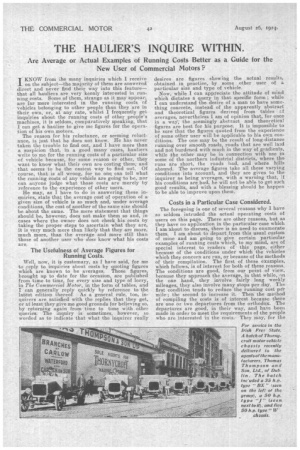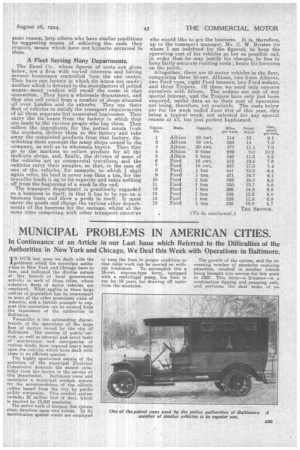THE HAULIER'S INQUIRE WITHIN.
Page 12

Page 13

If you've noticed an error in this article please click here to report it so we can fix it.
Are Average or Actual Examples of Running Costs Better as a Guide for the New User of Commercial Motors ?
T KNOW from Lhe many inquiries which I receive 1 on the subject—the majority of them are answered direct and never find their way into this feature— that all hauliers are very keenly interested in run-. ning costs. Some of them, strange as it may appear; are far more interested in the running costs of vehicles belonging to other people than they are in their own, or, at any rate, whilst I frequently get inquiries about the running costs of other .people's machines, it is seldom, comparatively speaking, that I can get a haulier to give me figures for the operation of his own motors.
The reason for his reluctance, or seeming reluctance, is just that he does not know. He has never taken the trouble to find out, and I have more than a suspicion that, in a good many cases, hauliers write to me for the running costs of a particular size of vehicle because, for some reason or other, they want to know what their own are costing them, and that seems to be the easiest way to find out. Of course, that is all wrong, for no one, can tell what the running costs of any vehicle are going to be, nor can anyone judge what those costs are merely by reference to the experience of other users.
He may, as I have to do in answering these inquiries, state that the average cost of operation of a given size of vehicle is so much and, under average conditions, the cost of another of the same size should be about the same. The mere statement that things should be, however, does not make them so and, in cases where the owner does not check his costs by taking the proper steps to ascertain what they are, it is very much more than likely that they are more, much more, than the average and more still than those of another user who does know what his costs are.
The Usefulness of Average Figures for Running Costs.
Well, now, it is customary, as I have said, for me i
to reply to nquiries about costs by quoting figures which are known to be averages. Those figures, brought up to date for the occasion, are published from time to time for every size and type of lorry, in The Commercial Motor, in the form of tables, and I can generally reply quickly by reference to the latttst edition thereof As a general rule, too, inquirers are satisfied with the replies that they get, or at least they give me good grounds for believing so, by returning again from time to time with other queries. The inquiry is sometimes, however, so worded as to indicate that what the inquirer really
desires are figures showing the actual results, obtained in practice, by some other user of a particular size and type of vehicle.
Now, while I can appreciate the attitude of mind which dictates a query in that specific form ; while I can understand the desire of a man to have something concrete, instead of the apparently abstract and theoretical figures derived from tables cf averages, nevertheless I am of opinion that, for once in a way, the seemingly abstract and theoretical figures are best for his purpose. It is impossible to be sure that the figures quoted from the experience of some other user will be applicable to his own conditions. The one may be the result of long-distance running over smooth roads, roads that are well laid and not burdened with much in the way of gradients, while the other may be in connection with use in some of the northern industrial districts, where the runs are short, the roads bad, and where hills abound. The average figures take all these varying conditions into account, and they are given to the inquirer as being averages, with a warning that, if his conditions are.bad, he will not be able to get such good results, and with a blessing should he happen to be able to improve upon them.
Costs in a Particular Case Considered.
The foregoing is one of several reasons why I have so seldom intruded the actual operating costs ot users on this page. There are other reasons, but as they have no application in theY particular case which I am about to discuss, there is no need to enumerate them. I am about to depart from this usual custom of mine and am . going to give certain particular examples of running costs which, to my mind, are of special interest to readers of this page, either because of the conditions under which the vehicles which they concern are run, or because of the methods of their compilation. The first of these examples, which follows, is of interest for both of these reasons. The conditions are good, from our point of view, because they approach the average, in that while, en the one hand, they involve fairly long weekly mileages, they also involve many stops per day. The first condition tends to reduce the running cost pi' mile ; the second to increase it. Then the method of compiling the costs is of interest because there are one or two departures from the orthodox. The departures are good, in their way, and have been made in order to meet the requirements of the people who are interested in the costs.They may, for the For service in the Irish Free State. A batch of Thornycroft motor vehicle chassis recently delivered to the agents of themanufacturers, Thomas Thompson and Son. Ltd., of Dubtin. The batch Mended a 35 h.p. type " BX " (seen on the left of the group), a 50 h.p. type "J" (seen next to it), and five 50 h.p. type" W chassis. same reason, help others who have similar conditions by suggesting means of achieving the, ends they require, means which have not hitherto occurred to them.
A Fleet Serving Many Departments.
The Excel Co., whose figures of costs are given below, are a firm with varied interests and having several businesses controlled !rom the one centre. They have one factory in which tin boxes are inade ; another which is devoted to the manufacture of potted meats-many readers will recall the name in that connection. They have a wholesale department, and they also sell retail from a number of shops situated all over London and its suburbs. They use their fleet of Vehicles to satisfy the transport requirements of all these separate but associated businesses. They carry the tin boxes from the factory .in which they are made to the various people who buy them. They collect the ingredients for the potted meats from the markets, deliver them to the factory and take away the completed products from that factory, distributing them amongst the many shops owned by the company, as well as to wholesale buyers. Then they go to the markets to collect produce for all the multiple shops, and, finally, the drivers of some of the vehicles act as commercial travellers, and the vehicles carry their samples, so that, in the case of one of the. vehicles, for example, to which I shall again refer, its load is never less than a ton, for the traveller loads it up to its capacity and takes nothing off from the beginning of a week to the end. The transport department is practically regarded as a business in itself, in that it has to be run on a business basis and show a profit in itself. It must carry the goods and charge the various other departments of the business for the cartage, whilst at the same time competing with other transport concerns
who would like to get the business. It is, therefore, up to the transport manager, Mr. C. W. Brister to whom I am indebted for the figures), to keep the operating cost of his vehicles as low as possible and, in order that he may justify his charges, he has to keep fairly accurate running costs ; hence his keenness on the point.
Altogether, there are 20 motor vehicles in the fleet, comp-ising three. 30-cwt. Albions, two 2-ton Albions, two Ford vans, eight Ford tonners, two Ford sedans, and three Trojans. Of these we need only concertt ourselves with fifteen. The sedans are not of any special interest, and the Trojans have only just been acquired, useful data as to their cost of operation not being, therefore, yet available. The costs below are for the week ended June 21st of this year, this being a typical week, not selected for any special reason at all, but just picked haphazard.






























